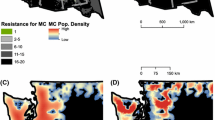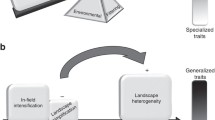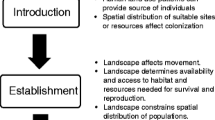ABSTRACT
Scale-specific patterns of resource distribution on landscapes entrain attributes of resident animal communities such that species body-mass distributions are organized into distinct aggregations. Species within each aggregation respond to resources over the same range of scale. This discontinuous pattern has predictive power: invasive species and extinct or declining species in landscapes subject to human transformation tend to be located at the edge of body-mass aggregations (P < 0.01), which may be transition zones between distinct ranges of scale. Location at scale breaks affords species great opportunity, but also potential crisis.
Similar content being viewed by others
Author information
Authors and Affiliations
Additional information
Received 19 May 1998; accepted 24 November 1998
Rights and permissions
About this article
Cite this article
Allen, C., Forys, E. & Holling, C. Body Mass Patterns Predict Invasions and Extinctions in Transforming Landscapes. Ecosystems 2, 114–121 (1999). https://doi.org/10.1007/s100219900063
Issue Date:
DOI: https://doi.org/10.1007/s100219900063




